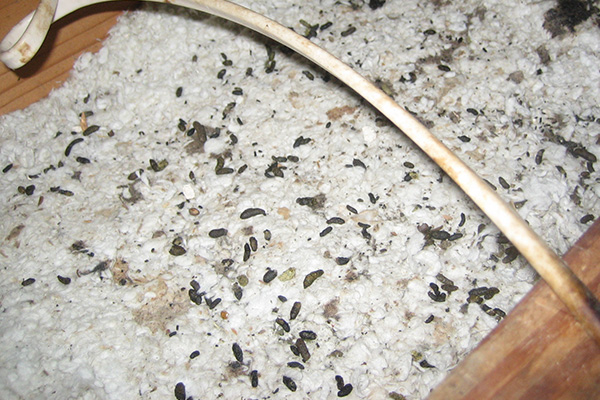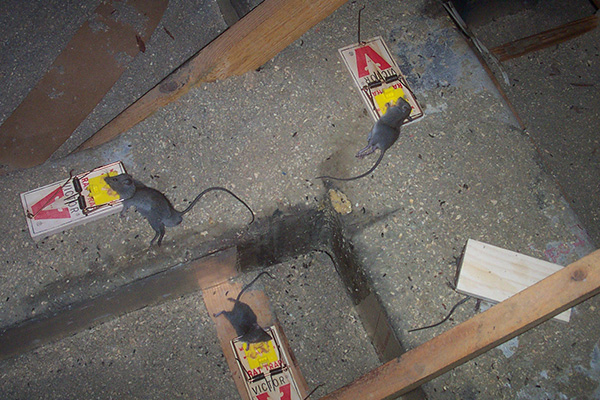- info@animalatticpest.com
- Call - we service 300 locations

How To Find and Remove Dead Rats In the Attic or Walls
Rats that live in your house also die in your house. The life cycle of most species of rats is very short - usually only a few months, and rarely more than a year. They breed in high numbers, and they
also die in high numbers. Out in the wild, most rats are quickly eaten by housecats, owls, fox, snakes, and all sorts of predators. But in the safety of your home, they just may get to die of old age! More
commonly, rats die in your attic, especially in higher numbers, because someone has applied a rat poison (rodenticide). While it's true that not all the rodents in the attic will eat the poison and die,
several will, and they die in your attic or walls. You may be reading this page if that has happened to you, because it causes a terrible odor! The smell of decomposing rats is horrible - just one rat can
stink up a whole house for weeks. The only way to solve the odor problem is to find and remove the dead rat carcasses.
To find and remove the carcasses, you have to literally sniff them out. There is no magic odor detecting tool to find them, other than your nose. The only other option is a thermal camera, because a rotting rat
will give off a little heat. But it's subtle. Your best option is to enter the attic and sniff, sniff, sniff around until you find a rat, and then bag it, and spray the area with an effective cleaner. I like
enzyme-based cleaners, but you can use a bleach cleaner if you like. Be sure to remove all maggots and body juices and soiled insulation. If a dead rat carcass is inside a wall or drop ceiling or any other
inaccessible cavity, the best method is to move back and forth, with your nose against the wall or ceiling, sniffing and sniffing. It's a bit of work, but once you come directly on top of the spot with a dead
rodent, you will know it - the smell changes. Use a drywall saw to cut a hole in that spot, and remove the dead animal. If you've used poison, there could be several rats, so keep looking! Once you think you've
gotten them all out, open the windows to air out the place!
Photographs of Dead Rats and Odor in the Attic
Poison Results in Stinky Dead Rats!
This is just one of the reasons I don't recommend the use of poison - it kills rats in the attic, and then you have to deal with the terrible odor!
Look at the Blue Feces
A customer called me to find the source of the terrible smell. Look at the blue feces around this rat carcass. That's from the blue die in the poison.
Rat Feces Can Cause Odor Too
This page is about finding a dead rat carcass, but remember that all of the feces and urine they leave in the attic or walls is also a source of odor.
Trapping Them Ensures Removal
A dead rat in a trap is of course a source of odor. So don't forget that. But of course, if you trap them, you know where they are, and they are easy to get.
Information About How To Find and Remove Dead Rats In the Attic or Walls
There are several reasons that you may end up with dead rats in your attic or walls. Sometimes, the rats will simply die naturally, particularly when there is a large colony living in your attic. Other times, a homeowner will make a poor decision and decide to poison rats in their home to kill them. When this happens, instead of knowing that you can find the dead rat in the snap trap you set out, you will have to search to find it in the walls or attic before it begins to rot. No matter the reason, as soon as you know there is a dead rat in your walls or attic, you need to find it and remove it. The smell will only get worse and more pests like flies and maggots will be attracted.
Know The Most Common Areas
You will have a better chance of finding the dead rats in your walls or attic quickly if you know where to look, something which comes down to an understanding of rats’ habits. In most cases, a rat that is about to die will experience lower body temperatures because of circulation being affected. Because of this, they will seek warmth upon their death beds. If you are lucky, that means that you can find the dead rat right in its nest, since it is not only warm but also offers a feeling of security. Other times, the rats may seek warmth from areas by lights or your chimney. It is also possible that the dying rat felt dehydrated and went in search of food and water. In this case, you may find it by or on the way to your home’s plumbing.
Use Your Nose
While knowing the most likely spots to find the dead rat can help to some extent, you will still need to search. Your nose is the best tool for finding dead rats as they will begin to smell. Take your time and sniff your house carefully, trying to track changes in the scents. You will also need to use a bit of common sense when following the smell since ventilation can affect it. Pay attention to when as well as where the smell is the strongest. If you notice it most when you use your shower, check the water pipes by your bathroom. If you notice it when you turn on your stove, then it is probably close to there since the warm air makes the decay scents stronger.
Remove The Rat
Unless you get lucky, you will have to make a hole in your wall or ceiling to get to the dead rat. This is why it is so important to narrow down its location beforehand; you want to reduce the damage you do to your home and the repairs needed. When it comes time to remove the rat, be sure to always wear sturdy vinyl, latex, or rubber gloves. Even so, you should still hold the rat with a paper towel or rag you plan on tossing. You will need to put the rodent in a bag which you tightly seal and then double bag. You can throw it out with your regular trash, but be sure to put it in a covered can until collection day to avoid odors and attracting insects or other animals.
Clean The Area
You should clean the area where you found the dead rat at the same time you remove it. You will need to wear gloves for this as well for your own protection. The CDC actually suggests spraying a disinfectant or combination of water and bleach on the dead rodent and surrounding area and letting this sit for five minutes before removing the dead animal. To effectively clean the area, most wildlife removal professionals will suggest using an enzymatic cleaner which breaks down the bacteria found around the body.
Hire A Professional
It is possible to find and remove a dead rat by yourself, but the process will go much more smoothly if you hire a professional to do it for you. They will already know the most likely spots that you will find the rat and their experience sniffing out dead animals in the walls means that they will be able to locate it more quickly. Professionals are also more likely than you to find the rat on their first try, meaning they will only have to open up the wall or ceiling once while you may have to do it several times. Fewer repairs are always preferred. Best of all, if you hire a professional, you won’t have to deal with removing the rat or cleaning the area at all. They will most likely take care of every part of this for you. While they are there, they can also help you remove any other rodents in your home and prevent more from entering in the future.




